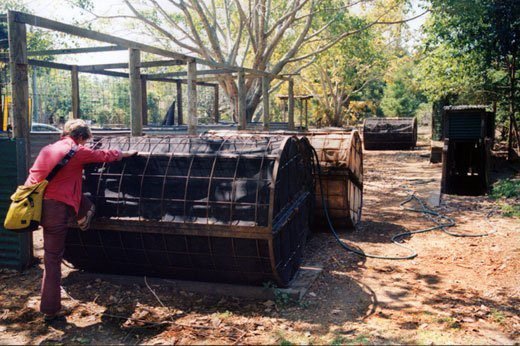Story & photos: Russ Grayson
THE CLEVER MAVENS at Northey Street City Farm developed a new way to make compost a few years ago.
Nothing small scale and modest for this innovative lot, they wanted compost in substantial quantities in a short time. It’s a big city farm, after all.

So, what did they do? They made compost rollers several metres in length and over a metre in diameter by attaching steel mesh to a welded steel frame. This created a cylinder that was lined with shadecloth. They mmanufactured not just one but several of the steampunk-looking devices.
The rollers are hinged and open clamshell-like to fork green waste into, then closed and locked. They are rolled along a rolling alley by two or more people to mix the compost materials, aerate them and to get water through the mix.
It’s the same principle as those compost rollers on stands you can buy, only scaled up. And, in doing that, the Northey Street crew demonstrate one of the principles of sustainable design for community-based projects — scaling up.
They also demonstrate other sustainability design principles — those of replicability and open source hardware. The roller was copied by the Beelarong community gardeners (Morningside, Brisbane) and a couple were fabricated in Honiara, Solomon Islands, by the Kastom Gaden Association and TerraCircle Inc crew. This makes Northey Street City Farm the first in Australia to export an innovative technology they developed themselves.
DIFFICULTY: High. Needs skills in metalwork, DIY industrial design, imagination.
EFFECTIVENESS: Reportedly good. Needs large volume of green waste to feed the thing.
SCALABILITY: Represents a scaling-up of existing compost roller technology. Too cumbersome to scale-up further. The design is probably the upper limit for a hand-powered technology of this type.
REPLICABILITY: Good, providing the design and construction skills are present (or there are funds to have the technology fabricated at an engineering works) and the materials obtainable at low cost.
MAINTENANCE SCALE:
Materials: Low maintenance needs due to the durable materials and construction.
Skills: Maintenance skills available.





